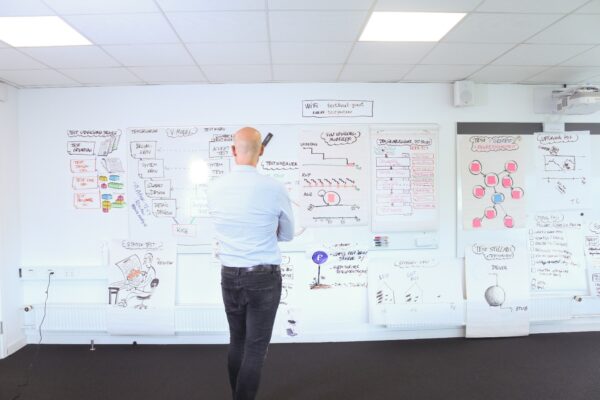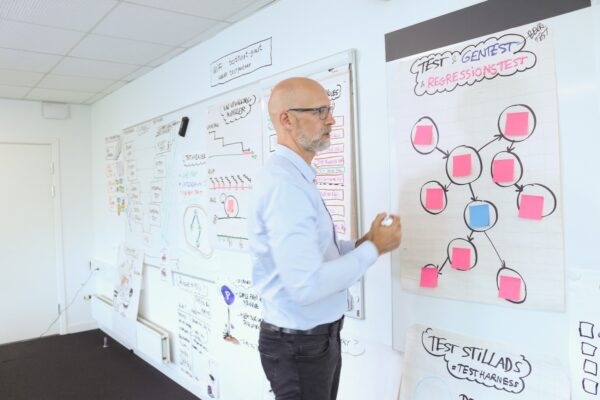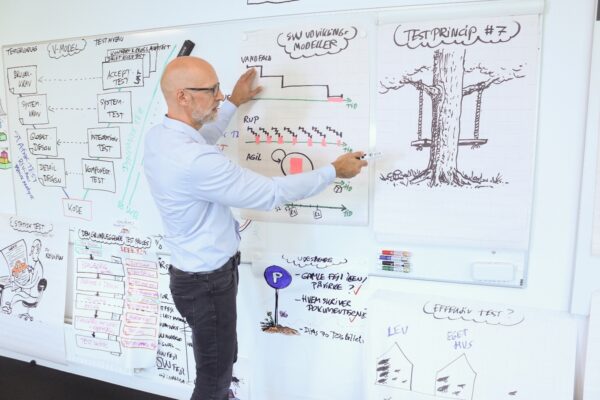We are in the midst of a shift in the techno-economic paradigm. This is clear from the enormous surge of new technologies and products emerging every day. These new methods and technologies present organizations with various challenges, such as:
- How fast can we adapt to changing customer expectations and behaviors?
- What ethical and regulatory concerns do new technologies bring with them?
- How do we mitigate the risks effectively?
- How can our organization benefit and thrive under continuous change?
These challenges are not new. Companies that have made efforts toward digital transformation have dealt with some of the same challenges. However, when the pandemic outbreak happened, companies that were not transformed into a more digital work culture were forced to reassess their strategy and speed up their digital transformation in response. From that experience, we learned that companies that act proactively when met with the challenges of change could keep their momentum more easily than those that operate with hesitation.
“The world is once again at a crossroads where explanations and guiding criteria are sorely needed.” – (Perez, 2002)
This quote by Carlota Perez from her 2002 book “Technological Revolutions and Financial Capital – The Dynamics of Bubbles and Golden Ages” is even more true today. Therefore, this blog will discuss how we can use the principles of learning organizations and the mindset of Quality Assurance and Software Testers to establish a foundation of guiding criteria that organizations can use proactively when navigating the needs of the next economy.

The Value of Learning Organizations
How should your organization adapt to the trends of continuous change that have become the new normal?
The most straightforward answer is: Learn and adapt to new ways quickly! This answer resonates in a Deloitte study from 2019, where over 9000 people from different fields participated. The study identified some key company trends. Two important ones were:
- Teach workers new skills
- Turn into learning-focused cultures
Another interesting study by the Association for Talent Development (ATD) showed that businesses that invest in employee training see a 24% higher profit margin and an impressive 218% more income per worker than those that do not use formal training. This ATD study examined public companies in 1996, 1997, and 1998. Again, if we are to learn from the past, the message is clear:
Welcome new methods by building a culture of ongoing learning and skill growth! Aim to use the best learning practices and make them part of the company’s core. By doing this, your company can advance in a quickly changing world with lots of new technology!

Guiding Criteria for QA in Learning Organizations
A learning organization is defined by its ability to adapt, innovate, and evolve by acquiring and applying new knowledge. In addition, these organizations prioritize employee growth, collaboration, and shared learning to improve product quality and customer satisfaction.
For software testers and QA teams, this means staying current with the latest testing methodologies, tools, and industry best practices. In order to fully support the transformation into a learning organization, QA teams and software testers should prioritize the following five key areas:
- Continuous Learning: Take part in regular training and growth activities, go to industry events and conferences (Like EuroSTAR), and stay current with the newest software testing and QA trends. Make time for learning, use online resources, and participate in webinars and specialized courses.
- Cross-functional Collaboration: Remove barriers by forming mixed teams and promoting open conversation. This helps to make sure new ideas are shared throughout the company. For example, create a team that combines members from marketing, development, and customer support departments. Encourage them to share ideas openly and hold regular meetings to discuss progress. This approach helps spread fresh perspectives and valuable insights across the entire organization instead of being isolated to one department.
- Reflect and Iterate: Use Agile methodology practices like sprint reviews and retrospectives to find ways to improve and make changes as needed. Build a safe environment where workers feel comfortable discussing their thoughts and feedback.
- Knowledge Sharing: Implement innovation sprints to explore new ideas, establish communities of practice for software testing and QA professionals, and adopt frameworks like SAFe (Scaled Agile Framework) to ensure alignment across the organization. Encourage team members to share insights and experiences through internal workshops and external events. Create a centralized knowledge repository to store this information, making it easily accessible, updatable, and traceable to its source.
- Mentorship Programs: Start programs to help less experienced software testers and QA professionals grow and develop. Have clear goals and give mentors the resources and support they need.

To measure the success of these initiatives, companies can track key performance indicators (KPIs) such as employee engagement, knowledge retention, process efficiency, and product quality to know if these efforts work. In addition, regular check-ins can help find more ways to improve and ensure the learning organization method is used well in software testing and QA tasks.
These efforts work best when leaders take charge. First, they should share a clear goal and show workers how important it is to keep learning, adjusting, and growing. Then, leaders need to do what they say by setting an example and joining in on learning and adapting efforts. This way, they show that they believe in using new knowledge.
In conclusion
Navigating the ever-changing landscape of technology and innovation requires organizations to embrace a culture of continuous learning and adaptation. By focusing on the principles of learning organizations and leveraging the mindset of Quality Assurance and Software Testers, companies can establish a strong foundation for proactively addressing change challenges.
Organizations can create an environment encouraging growth, innovation, and resilience by investing in continuous learning, promoting cross-functional collaboration, reflecting and iterating, sharing knowledge, and fostering mentorship programs. Tracking key performance indicators and regular evaluations will ensure the effectiveness of these efforts, and strong leadership will set the stage for success.
In a world where change is the only constant, embracing a learning-oriented culture and fostering a proactive approach to new challenges will ensure that your organization survives and thrives in the face of continuous change.
EuroSTAR Huddle shares articles from our community. Check out our library of online talks from test experts and come together with the community in-person at the annual EuroSTAR Software Testing Conference. The EuroSTAR Conference has been running since 1993 and is the largest testing event in Europe, welcoming 1000+ software testers and QA professionals every year.